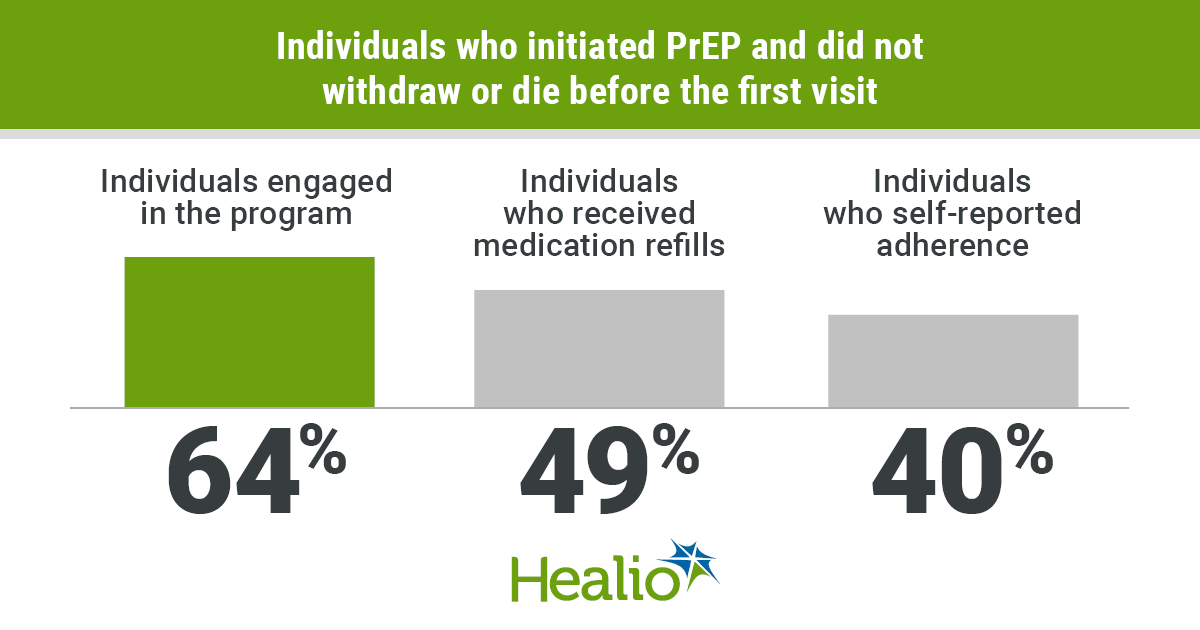One-third of patients taking PrEP in Kenya, Uganda demonstrate poor adherence
One-third of patients at an elevated risk for HIV who initiated pre-exposure prophylaxis, or PrEP, in Kenya and Uganda had drug concentrations in hair samples that were consistent with poor adherence, suggesting a need for new approaches and long-acting formulations of this agent, according to a study published in Lancet HIV.
“In generalized epidemic settings, strategies are needed to identify and engage individuals who might benefit from HIV prevention services, including PrEP,” the authors wrote. “Most studies in sub-Saharan Africa have offered PrEP to prespecified populations who are at high risk, such as young women, sex workers and serodifferent couples, who either present to clinical care or are selectively recruited from the community. Comprehensive HIV testing and universal access to PrEP for all people without HIV who are at high risk of infection presents an opportunity to offer PrEP to people who might not otherwise engage in health systems and to assess PrEP engagement at a population level.”
Catherine A. Koss, MD, assistant professor of medicine in the division of HIV, infectious diseases and global medicine at University of California, San Francisco, and colleagues performed a 72-week interim analysis of the ongoing Sustainable East Africa Research in Community Health, or SEARCH, study. They evaluated PrEP uptake within 90 days of HIV testing, program engagement (defined as follow-up visit attendance at weeks 4 and 12 and every 12 weeks thereafter), self-reported adherence up to 72 weeks, refills and concentrations of tenofovir in hair samples from individuals who reported HIV risk and adherence during follow-up. They also examined factors associated with uptake and adherence.
Between June 2016 and June 2017, Koss and colleagues analyzed data from 70,379 residents aged 15 years and older who were HIV-negative and who were included in population-level testing for the virus. Of those patients, 69,121 tested negative for HIV, including 12,935 participants with an increased risk for HIV risk. Risk factors included a serodifferent partnership (n = 1,353; 10%), empirical risk score (n = 6,938; 54%) and self-identified risk for HIV (n = 4,644; 36%).

Approximately a quarter of these patients (n = 3,489; 27%) started PrEP; 2,865 (82%) participants did so the same day they were tested for HIV. Half of these patients (n = 1,733; 50%) were men. Koss and colleagues found that PrEP uptake was decreased among individuals aged 15–24 years (adjusted OR = 0.55; 95% CI, 0.45-0.68) and mobile individuals (adjusted OR = 0.61; 95% CI, 0.41-0.91).
At week 4, among 3,466 participants who started PrEP and did not die or withdraw before their first visit, 64% were engaged in the program, 49% received medication refills and 40% self-reported adherence. At week 72, 56% were engaged in the program, 33% received a refill and 27% self-reported adherence.
For participants who reported HIV risk from weeks 4 to 72, refills (89%-93%) and self-reported adherence (70%-76%) were high. Among sampled participants who self-reported adherence at week 24, the proportion with tenofovir concentrations in their hair reflecting at least four doses taken per week was 66%; 44% reflected at least seven doses per week.
“To have a population-level effect, PrEP needs to be delivered at scale and in combination with universal access to HIV testing and treatment. The SEARCH study shows that such universal access is possible,” Connie Celum and Jared M. Baeten, of the University of Washington’s department of global health, medicine and epidemiology, wrote in an accompanying editorial. “These results should motivate additional innovations in ways to increase PrEP uptake and adherence overall, and particularly among young adults and mobile populations.”
Participants who stopped taking PrEP were receptive to HIV testing at 4,274 (83%) of 5,140 subsequent visits; half of these participants later resumed PrEP. Serious adverse events were reported in 29 participants who started PrEP, including seven deaths. Five grade 3 adverse events were believed to potentially be related to the study drug.
“As PrEP roll out expands in generalized epidemic settings, our study provides insights into real-world implementation gaps in the PrEP cascade and suggests that further interventions are needed to maximize uptake and adherence, particularly among young adults and mobile populations,” Koss and colleagues wrote. “Novel strategies are needed to foster sustained engagement and adherence to oral PrEP and future long-acting formulations.”
“Future research should evaluate whether sexual behavior data improve risk score performance (and optimal methods to facilitate disclosure and discussions on sexual health),” the researchers concluded. “Additionally, written consent was required to initiate PrEP, which might limit generalizability to settings now offering PrEP within routine care.” – by Eamon Dreisbach
Disclosures: Koss reports receiving grant support paid to the University of California, San Francisco from the Gilead Research Scholars Program in HIV. Please see the study for a list of all other authors’ relevant financial disclosures.

